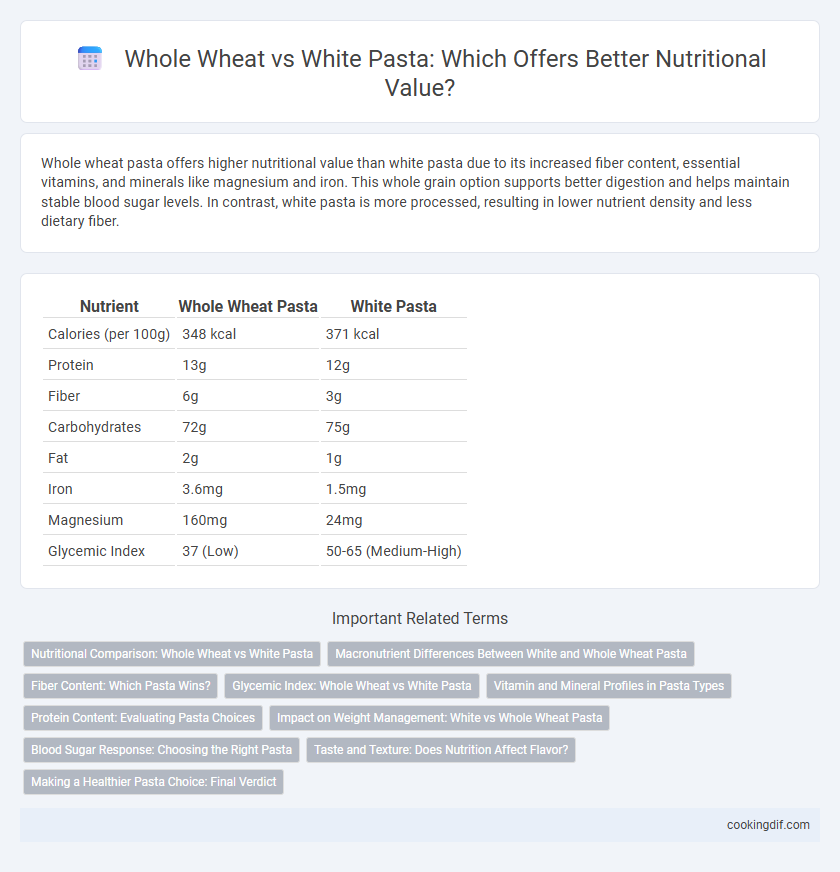Whole wheat pasta offers higher nutritional value than white pasta due to its increased fiber content, essential vitamins, and minerals like magnesium and iron. This whole grain option supports better digestion and helps maintain stable blood sugar levels. In contrast, white pasta is more processed, resulting in lower nutrient density and less dietary fiber.
Table of Comparison
| Nutrient | Whole Wheat Pasta | White Pasta |
|---|---|---|
| Calories (per 100g) | 348 kcal | 371 kcal |
| Protein | 13g | 12g |
| Fiber | 6g | 3g |
| Carbohydrates | 72g | 75g |
| Fat | 2g | 1g |
| Iron | 3.6mg | 1.5mg |
| Magnesium | 160mg | 24mg |
| Glycemic Index | 37 (Low) | 50-65 (Medium-High) |
Nutritional Comparison: Whole Wheat vs White Pasta
Whole wheat pasta contains higher fiber content, providing around 6 grams per serving compared to 2 grams in white pasta, which supports better digestion and prolonged satiety. It also offers more vitamins and minerals, including B vitamins, iron, and magnesium, absent or reduced in refined white pasta due to the milling process. White pasta, though lower in fiber and nutrients, is often enriched with folic acid and iron to partially compensate for its reduced nutritional profile.
Macronutrient Differences Between White and Whole Wheat Pasta
Whole wheat pasta contains higher amounts of fiber and protein compared to white pasta, offering approximately 6 grams of protein and 6 grams of fiber per serving, whereas white pasta typically provides around 5 grams of protein and less than 2 grams of fiber. The complex carbohydrates in whole wheat pasta digest more slowly, resulting in a lower glycemic index that helps maintain stable blood sugar levels. White pasta has a higher glycemic index and fewer micronutrients due to the refining process that removes bran and germ components present in whole wheat pasta.
Fiber Content: Which Pasta Wins?
Whole wheat pasta contains significantly higher fiber content compared to white pasta, with approximately 6 grams of fiber per 2-ounce serving versus 2 grams in white pasta. The increased fiber in whole wheat pasta supports better digestion, promotes satiety, and helps regulate blood sugar levels. Choosing whole wheat pasta is a superior option for those seeking enhanced nutritional benefits through higher dietary fiber intake.
Glycemic Index: Whole Wheat vs White Pasta
Whole wheat pasta has a lower glycemic index (GI) compared to white pasta, typically ranging between 37 and 50, which helps maintain more stable blood sugar levels. White pasta usually has a higher GI, around 50 to 65, leading to quicker blood sugar spikes. Choosing whole wheat pasta supports better glycemic control and sustained energy release, beneficial for managing diabetes and weight.
Vitamin and Mineral Profiles in Pasta Types
Whole wheat pasta contains higher levels of essential vitamins and minerals compared to white pasta, including B vitamins like niacin, thiamin, and folate, as well as minerals such as iron, magnesium, and zinc. The bran and germ preserved in whole wheat pasta contribute to its richer nutrient profile, promoting better metabolic function and cardiovascular health. White pasta, having been refined, lacks many of these nutrients due to the removal of the bran and germ during processing.
Protein Content: Evaluating Pasta Choices
Whole wheat pasta contains approximately 7-8 grams of protein per 2-ounce serving, surpassing the 5-6 grams found in white pasta, making it a superior choice for higher protein intake. The increased protein in whole wheat pasta supports muscle repair and growth, offering a nutrient-dense option for health-conscious consumers. Choosing whole wheat pasta can enhance dietary protein quality while providing additional fiber and micronutrients absent in refined white pasta.
Impact on Weight Management: White vs Whole Wheat Pasta
Whole wheat pasta contains higher fiber content and complex carbohydrates, promoting longer satiety and aiding in weight management compared to white pasta's refined grains that digest quickly and may cause blood sugar spikes. The increased protein and essential micronutrients in whole wheat pasta contribute to better metabolic health and reduced calorie intake. Choosing whole wheat pasta supports sustained energy release, which can help control hunger and prevent overeating, making it a favorable option for weight control.
Blood Sugar Response: Choosing the Right Pasta
Whole wheat pasta contains more fiber and nutrients than white pasta, which slows carbohydrate absorption and helps maintain stable blood sugar levels. White pasta, made from refined flour, causes quicker blood sugar spikes due to its lower fiber content. Selecting whole wheat pasta supports better glycemic control and reduces the risk of insulin resistance.
Taste and Texture: Does Nutrition Affect Flavor?
Whole wheat pasta contains more fiber and protein than white pasta, which influences its denser texture and nuttier flavor, often perceived as heartier and more robust. White pasta has a smoother, softer texture and milder taste due to the refined flour, appealing to those who prefer a lighter mouthfeel. Nutritional differences such as higher fiber in whole wheat contribute to a chewier bite, while the lower fiber in white pasta results in a silkier, more delicate flavor profile.
Making a Healthier Pasta Choice: Final Verdict
Whole wheat pasta offers higher fiber, protein, and essential micronutrients like magnesium and zinc compared to white pasta, aiding digestion and supporting heart health. The lower glycemic index of whole wheat pasta helps maintain stable blood sugar levels, making it a better option for weight management and diabetes control. Choosing whole wheat pasta aligns with nutritional goals for a balanced diet and long-term health benefits.
Whole wheat vs white pasta for nutritional value Infographic

 cookingdif.com
cookingdif.com